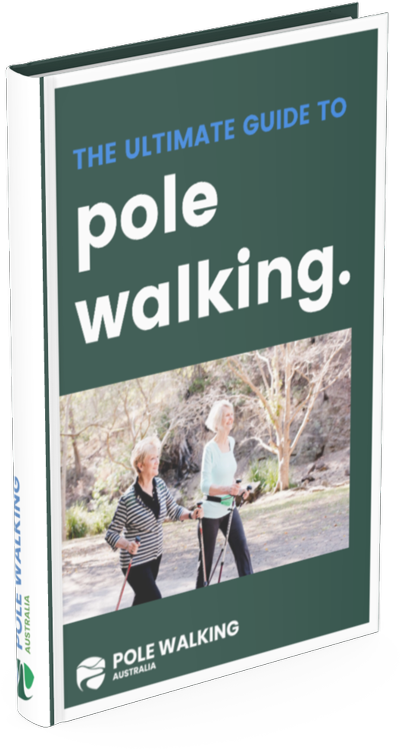The complete guide to walking poles

How do I choose a walking pole?
There are many questions that you can ask when choosing walking poles. What do I want the poles for? How much am I prepared to pay? Do I want a pole to be sturdy or light and portable? Do I want straps or not? The possibilities are endless and so are the types of poles.
Firstly, decide on what you want the poles for. Once that is decided, then many other considerations fall into place.
There are three main uses for poles. The first is for hiking, trekking, snow shoeing or off road walking. The second is for Nordic walking. The third is for use as a walking aid.
If you are interested in using poles for hiking, then chances are you would want something light, collapsible and portable. That makes it easier to fold them up and put them away when they are not needed for climbing mountains or crossing streams. Poles that are solely used for hiking usually have small rubber removeable tips on the ends.
Nordic walking is a specific learned fitness technique and not simply walking with poles like when you are hiking. The poles are planted diagonally behind the user in order to propel them along and have special features that enable the walker to push down and back without gripping hard. The technique is continuous, with an opposite arm and leg movement, like marching. They have slanted boot shaped tips because the technique requires the user to place the poles at an angle behind them. Using the power of the back, arms and core as well as the legs uses more energy and works more muscles than when walking without poles. This makes them ideal as a low impact fitness tool.
Nordic walking poles usually fall into two categories, strapped and unstrapped poles. Strapped poles enable the push back technique by having a half glove strap which attaches you to the pole and enables open the hand when pushing an close when pulling up. So you use a grip and release technique with every step.
Unstrapped poles such as Urban Poles, have a specially designed shelf at the bottom of the hand grip and this allows you to push down and back without needing to grip tightly. The technique uses a continuous light grip so does not require the coordination of the strapped method.
Poles are also used as a walking aid for people who have difficulty in getting about in their day to day lives. They are used as an alternative to single sticks, canes, crutches or walkers. These poles need to be sturdy and safe and usually have an ergonomically designed hand grip with a shelf. They have large flat boot tips that increase the stability of the pole when it is being used. They are often prescribed by physiotherapists or other health professionals.
Poles vary in cost between very cheap single poles and quite expensive carbon fibre poles with many features. Keep in mind when purchasing poles that you usually get what you pay for. Having said that, most reputable walking pole manufacturers have good mid range poles. Most good poles will have specifications and descriptions of the pole which will help you decide what you need.
What is the best walking pole to use?
Once you have decided what you want to use the poles for, then you can chose the best one to use.
If you want poles to hike with, then you can either look for specific hiking poles, or use Nordic walking poles. Look for poles that are light but sturdy. Hiking poles tend to be very light, often made of carbon fibre, and collapse into 2 or 3 pieces, so they can be folded and put in a back pack when not in use. However, the lighter and more collapsible a pole is, the less sturdy it tends to be. Check the manufacturers warranty and remember that there is always a possibility that they may break when you least expect it. You do not want a pole breaking at awkward moments on a hike.
Make sure that you have rubber trekking tips as well. They may be sold with the poles, or you can purchase them separately. This is because the ends of the poles are usually tungsten, which works well in mud, or soft surfaces, but can be really annoying, uncomfortable or even unsafe on harder rock surfaces.
Although Nordic walking poles can be used for hiking, hiking poles should never be used for Nordic walking. This is because Nordic walking is a fitness technique that requires a firm and continuous pushing movement with every step. Hiking poles do not have a way to support the arm when pushing down and back which means you have to grip the pole tightly and continuously. This can lead to discomfort, cramping, tingling and/or pain in the hands and fingers.
Nordic walking poles come in fixed lengths or as a 2 piece adjustable pole. Most Nordic walking instructors prefer to use adjustable poles so that as your technique improves, the pole can be lengthened or shortened to suit.
Nordic walking poles cannot be bought at camping or hiking shops, but come from specialty online stores or through NW instructors. Usually people who want to learn to Nordic walk do so from an instructor, and they will advise you on the best poles to buy. Many instructors have poles to try out before you purchase.
Poles used as walking aids are usually purchased on recommendation from a health care professional such as a physiotherapist. There are poles specially made for this purpose such as Activator Poles. Look for features such as ergonomic hand grips, no straps, flat bell-shaped tips for stability, anti-vibration features, and button locking systems for safety and ease of adjustment. They are held upright when you walk, unlike Nordic walking poles, but use a similar but simpler left leg/right arm technique.
What are the benefits of walking sticks (poles)?
The benefits of walking with poles are many and varied. Over 270 studies have looked into the benefits and here are 10 for you:
- It whittles your waist—Your abs tighten each time you push off with your poles. So if you walk at an average pace of 1000 steps per kilometre, that’s the equivalent of 1,000 abdominal contractions every kilometre or 1,800 each mile.
- Your knees and hips will thank you—The poles let you offload weight from your hips and knees into your upper body. You can walk further, faster and with a reduction of weight-bearing pain.
- It revs up the calorie burning—Research has found that walking with poles burns an average of 20% and up to 46% more calories than standard walking.
- It sculpts your arms and shoulders— Nordic walking uses 90 percent of your muscles. So while walking is a great exercsie for leg muscles, adding poles will pull in the often underused upper body muscles, pecs, triceps, and biceps.
- It helps balance your blood sugar—The full-body workout with poles helps keep blood sugars in a healthy range. This is especially important for those who are pre-diabetic or diabetic.
- You’ll straighten up and feel more confident—Your upper back muscles (the ones that pull your shoulders back) tighten each time you plant your poles and push down and back which is with every step.
- It’s a fun social workout—Because Nordic walking is relatively cheap, easy and accessible to a large range of physical abilities, friends and family members can get together to walk and talk.
- It’s an amazing stress buster—The smooth rhythmic action provides a distraction from everyday concerns and lifts your mood. As it is an outdoor exercise, there is also an effect known as “green exercise” which researchers have found is also a mood booster.
- You can adjust the intensity—Urban poling is an energizing activity that can be enjoyed by people of any age and athletic ability. You can use the poles either to push more firmly and increase your walking workout, or, you can use them to help balance you if you are less confident when walking outdoors.
- It’s a great running alternative—Because Nordic walking is higher intensity than walking, but doesn’t jar the joints, it is a great alternative to running for older athletes, or runners recovering from injury. It also works well instead of trail running for those with injuries, or poor stability in their ankles.
Is it better to hike with one pole or 2?
Most camping and hiking shops sell hiking poles singly. Using one or two is generally a matter of preference if hiking, as opposed to Nordic walking, which is always done with two poles and a learned technique. Nordic walking poles are therefore only sold in pairs.
On a shorter hike or through easy terrain, which doesn’t require carrying a heavy pack or involve high level balance like stream crossings, one pole can be used.
With longer and more difficult treks, generally 2 hiking poles are well worth considering. The reason behind this is that there is more stability and it is easier to balance with two poles, especially if you have a heavy pack on your back.
Remember that when hiking, you generally don’t want to use up more energy, but rather, to save it. That means that you only use your poles when you need them, like when going up or down steep slopes, crossing streams, or on very rough terrain. They also help with stability and balance when you have a heavy pack on.
When choosing a non-paved trail for Nordic walking, as opposed to hiking, there are a few considerations to make. Remember that you will be using a continuous opposite arm and leg technique, so make sure the path is wide enough to cope with feet plus poles. Also, although poles are great for hills, any rock scrambling will mean you can’t use them. Therefore, flat or hilly, but not mountainous, terrain is best. You can purchase Nordic walking poles that have extra sand /snow baskets and even trekking tips so that they can convert easily to trekking poles.


